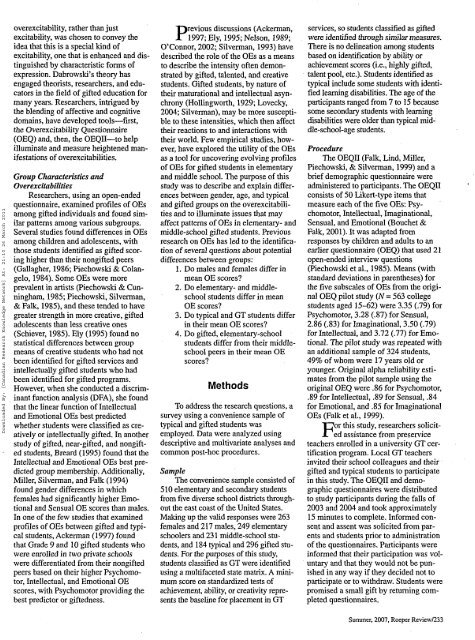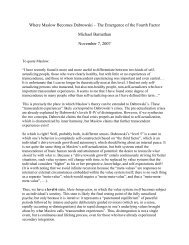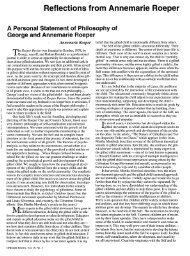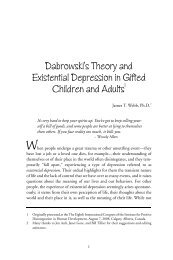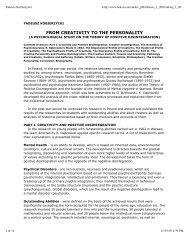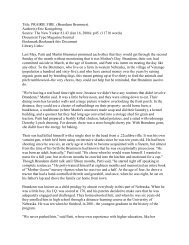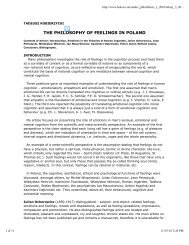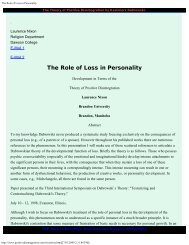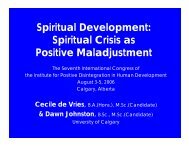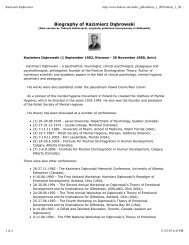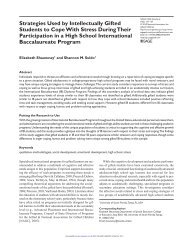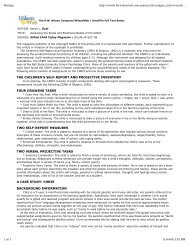Patterns of Overexcitability Overexcitabilities - Kazimierz ...
Patterns of Overexcitability Overexcitabilities - Kazimierz ...
Patterns of Overexcitability Overexcitabilities - Kazimierz ...
Create successful ePaper yourself
Turn your PDF publications into a flip-book with our unique Google optimized e-Paper software.
Downloaded By: [Canadian Research Knowledge Network] At: 21:10 26 March 2011overexcitability, rather than justexcitability, was chosen to convey theidea that this is a special kind <strong>of</strong>excitability, one that is enhanced and distinguishedby characteristic forms <strong>of</strong>expression. Dabrowski's theory hasengaged theorists, researchers, and educatorsin the field <strong>of</strong> gifted education formany years. Researchers, intrigued bythe blending <strong>of</strong> affective and cognitivedomains, have developed tools—first,the <strong>Overexcitability</strong> Questionnaire(OEQ) and, then, the OEQII—to helpilluminate and measure heightened manifestations<strong>of</strong> overexcitabilities.Group Characteristics and<strong>Overexcitabilities</strong>Researchers, using an open-endedquestionnaire, examined pr<strong>of</strong>iles <strong>of</strong> OEsamong gifted individuals and found similarpatterns among various subgroups.Several studies found differences in OEsamong children and adolescents, withthose students identified as gifted scoringhigher than their nongifted peers(Gallagher, 1986; Piechowski & Colangelo,1984). Some OEs were moreprevalent in artists (Piechowski & Cunningham,1985; Piechowski, Silverman,& Falk, 1985), and these tended to havegreater strength in more creative, giftedadolescents than less creative ones(Schiever, 1985). Ely (1995) found nostatistical differences between groupmeans <strong>of</strong> creative students who had notbeen identified for gifted services andintellectually gifted students who hadbeen identified for gifted programs.However, when she conducted a discriminantfunction analysis (DEA), she foundthat the linear function <strong>of</strong> Intellectualand Emotional OEs best predictedwhether students were classified as creativelyor intellectually gifted. In anotherstudy <strong>of</strong> gifted, near-gifted, and nongiftedstudents, Breard (1995) found that theIntellectual and Emotional OEs best predictedgroup membership. Additionally,Miller, Silverman, and Falk (1994)found gender differences in whichfemales had significantly higher Emotionaland Sensual OE scores than males.In one <strong>of</strong> the few studies that examinedpr<strong>of</strong>iles <strong>of</strong> OEs between gifted and typicalstudents, Ackerman (1997) foundthat Grade 9 and 10 gifted students whowere enrolled in two private schoolswere differentiated from their nongiftedpeers based on their higher Psychomotor,Intellectual, and Emotional OEscores, with Psychomotor providing thebest predictor or giftedness.Previous discussions (Ackerman,1997; Ely, 1995; Nelson, 1989;O'Connor, 2002; Silverman, 1993) havedescribed the role <strong>of</strong> the OEs as a meansto describe the intensity <strong>of</strong>ten demonstratedby gifted, talented, and creativestudents. Gifted students, by nature <strong>of</strong>their maturational and intellectual asynchrony(Hollingworth, 1929; Lovecky,2004; Silverman), may be more susceptibleto these intensities, which then affecttheir reactions to and interactions withtheir world. Few empirical studies, however,have explored the utility <strong>of</strong> the OEsas a tool for uncovering evolving pr<strong>of</strong>iles<strong>of</strong> OEs for gifted students in elementaryand middle school. The purpose <strong>of</strong> thisstudy was to describe and explain differencesbetween gender, age, and typicaland gifted groups on the overexcitabilitiesand to illuminate issues that mayaffect patterns <strong>of</strong> OEs in elementary- andmiddle-school gifted students. Previousresearch on OEs has led to the identification<strong>of</strong> several questions about potentialdifferences between groups:1. Do males and females differ inmean OE scores?2. Do elementary- and middleschoolstudents differ in meanOE scores?3. Do typical and GT students differin their mean OE scores?4. Do gifted, elementary-schoolstudents differ from their middleschoolpeers in their mean OEscores?MethodsTo address the research questions, asurvey using a convenience sample <strong>of</strong>typical and gifted students wasemployed. Data were analyzed usingdescriptive and multivariate analyses andcommon post-hoc procedures.SampleThe convenience sample consisted <strong>of</strong>510 elementary and secondary studentsfrom five diverse school districts throughoutthe east coast <strong>of</strong> the United States.Making up the valid responses were 263females and 217 males, 249 elementaryschoolers and 231 middle-school students,and 184 typical and 296 gifted students.For the purposes <strong>of</strong> this study,students classified as GT were identifiedusing a multifaceted state matrix. A minimumscore on standardized tests <strong>of</strong>achievement, ability, or creativity representsthe baseline for placement in GTservices, so students classified as giftedwere identified through similar measures.There is no delineation among studentsbased on identification by ability orachievement scores (i.e., highly gifted,talent pool, etc.). Students identified astypical include some students with identifiedlearning disabilities. The age <strong>of</strong> theparticipants ranged from 7 to 15 becausesome secondary students with learningdisabilities were older than typical middle-school-agestudents.ProcedureThe OEQII (Falk, Lind, Miller,Piechowski, & Silverman, 1999) and abrief demographic questionnaire wereadministered to participants. The OEQIIconsists <strong>of</strong> 50 Likert-type items thatmeasure each <strong>of</strong> the five OEs: Psychomotor,Intellectual, Imaginational,Sensual, and Emotional (Bouchet &Falk, 2001). It was adapted fromresponses by children and adults to anearlier questionnaire (OEQ) that used 21open-ended interview questions(Piechowski et al., 1985). Means (withstandard deviations in parentheses) forthe five subscales <strong>of</strong> OEs. from the originalOEQ pilot study (N = 563 collegestudents aged 15-62) were 3.35 (.79) forPsychomotor, 3.28 (.87) for Sensual,2.86 (.83) for Imaginational, 3.50 (.79)for Intellectual, and 3.72 (.77) for Emotional.The pilot study was repeated withan additional sample <strong>of</strong> 324 students,49% <strong>of</strong> whom were 17 years old oryounger. Original alpha reliability estimatesfrom the pilot sample using theoriginal OEQ were .86 for Psychomotor,.89 for Intellectual, .89 for Sensual, .84for Emotional, and .85 for ImaginationalOEs (Falk et al., 1999).Dr this study, researchers solicitedassistance from preserviceteachers enrolled in a university GT certificationprogram. Local GT teachersinvited their school colleagues and theirgifted and typical students to participatein this study. The OEQII and demographicquestionnaires were distributedto study participants during the falls <strong>of</strong>2003 and 2004 and took approximately15 minutes to complete. Informed consentand assent was solicited from parentsand students prior to administration<strong>of</strong> the questionnaires. Participants wereinformed that their participation was voluntaryand that they would not be punishedin any way if they decided not toparticipate or to withdraw. Students werepromised a small gift by returning completedquestionnaires.Summer, 2007, Roeper Review/233


